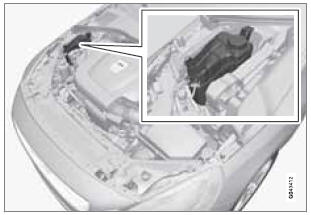Coolant


Location of the coolant reservoir
Normally, the coolant does not need to be changed. If the system must be drained, consult a trained and qualified Volvo service technician.
See page 341 for information on cooling system capacities.
CAUTION
- If necessary, top up the cooling system with Volvo Genuine Coolant/Antifreeze only (a 50/50 mix of water and antifreeze).
- Different types of antifreeze/coolant may not be mixed.
- If the cooling system is drained, it should be flushed with clean water or premixed anti-freeze before it is refilled with the correct mixture of water/antifreeze.
- The cooling system must always be kept filled to the correct level, and the level must be between the MIN and MAX marks. If it is not kept filled, there can be high local temperatures in the engine which could result in damage. Check coolant regularly!
- Do not top up with water only. This reduces the rust-protective and antifreeze qualities of the coolant and has a lower boiling point. It can also cause damage to the cooling system if it should freeze.
- Do not use chlorinated tap water in the vehicle's cooling system.
![]() WARNING
WARNING
- Never remove the expansion tank cap while the engine is warm. Wait until the engine cools.
- If it is necessary to top off the coolant when the engine is warm, unscrew the expansion tank cap slowly so that the overpressure dissipates.
See also:
Weight distribution affects handling
At the specified curb weight your vehicle has a tendency to understeer, which
means that the steering wheel has to be turned more than might seem appropriate
for the curvature of a bend. This ensu ...
Continuous wiping
The wipers operate at normal speed.
The wipers operate at high speed. ...
External sound sources
USB flash drive
To simplify the use of a USB flash drive, it is
advisable to only store music files on the drive.
It will take considerably longer for the system to index the files on the drive
...
